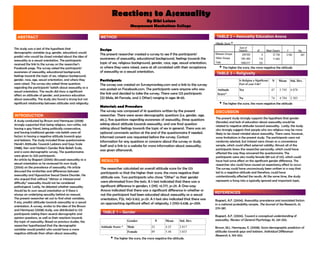
Reactions to Asexuality by Bibi Loizzo
- 1. INTRODUCTION METHOD A study conducted by Brown and Henriquez (2008) strongly supported that being religious, non-white, not having a gay friend, being politically conservative, and having traditional gender role beliefs were all factors in having a negative attitude towards gays and lesbians. The study included three questionnaires: Herek’s Attitudes Towards Lesbians and Gays Scale (1988), Kerr and Holden’s Gender Role Beliefs Scale, and a socio-demographic survey. The questionnaires were given to 320 participants. An article by Bogaert (2006) discussed asexuality as a sexual orientation as he reviewed his own study (2004) on the prevalence of asexuality. His article discussed the similarities and differences between asexuality and Hypoactive Sexual Desire Disorder. He also argued that without “distress or interpersonal difficulty” asexuality should not be considered pathological. Lastly, he debated whether asexuality should be its own sexual orientation or if there is always an underlying sexuality behind an asexual. The present researcher set out to find what variables, if any, predict attitudes towards asexuality as a sexual orientation. A survey, similar to the idea of the Brown and Henriquez (2008) study, was distributed to 123 participants asking them several demographic and opinion questions, as well as their reactions towards the topic of asexuality. Based on previous studies, the researcher hypothesized that the demographic variables would predict who would have a more negative attitude than others about asexuality. Design The present researcher created a survey to see if the participants’ awareness of asexuality, educational background, feelings towards the topic of sex, religious background, gender, race, age, sexual orientation, or where they were raised, were at all correlated with their acceptance of asexuality as a sexual orientation. Participants The survey was created on Surveymonkey.com and a link to the survey was posted on Facebook.com. The participants were anyone who saw the link and decided to take the survey. There were 123 participants (32 Male, 89 Female, and 2 Other) ranging in ages 18-65. Materials and Procedure The survey was composed of 16 questions written by the present researcher. There were seven demographic questions (i.e. gender, age, etc.), five questions regarding awareness of asexuality, three questions asking about attitude towards asexuality, and one final question asking about feelings towards the topic of sex in general. There was an optional comments section at the end of the questionnaire if needed. Informed consent was requested before the survey. Contact information for any questions or concerns about the survey or study itself and a link to a website for more information about asexuality, was given afterwards. RESULTS The researcher calculated an overall attitude score for the 123 participants so that the higher their score, the more negative their attitude was. Two participants who chose “Other” as their gender were eliminated from the tests. A t-test indicated that there was a significant difference in genders, t (119) =6.777, p<.01. A One-way Anova indicated that there was a significant difference in whether or not the participant had been educated about asexuality as a sexual orientation, F(6, 114)=3.162, p<.01. A t-test also indicated that there was an approaching significant effect of religiosity, t (119)=3.638, p=.059. TABLE 1 – Gender Reactions to Asexuality By Bibi Loizzo Marymount Manhattan College ABSTRACT This study was a test of the hypothesis that demographic variables (e.g. gender, education) would predict who would be closed minded about the idea of asexuality as a sexual orientation. The participants received the link to the survey on the researcher’s Facebook page. The survey asked the participants’ awareness of asexuality, educational background, feelings towards the topic of sex, religious background, gender, race, age, sexual orientation, and where they were raised. The survey also asked three questions regarding the participants’ beliefs about asexuality as a sexual orientation. The results did show a significant affect on attitudes of gender, and previous education about asexuality. The study also found a strong but not significant relationship between attitudes and religiosity. TABLE 2 – Asexuality Education Anova Bogaert, A.F. (2004). Asexuality: prevalence and associated factors in a national probability sample. The Journal of Sex Research, 41, 279-287. Bogaert, A.F. (2006). Toward a conceptual understanding of asexuality. Review of General Psychology, 10, 241-250. Brown, M.J., Henriquez, E. (2008). Socio-demographic predictors of attitudes towards gays and lesbians. Individual Differences Research, 6, 193-202. REFERENCES TABLE 3 – Religiosity DISCUSSION The present study strongly supports the hypothesis that gender (females) and lack of education about asexuality would be related to negative attitudes toward asexuality. Lastly, the study also strongly suggests that people who are religious may be more likely to be closed minded about asexuality. There were, however, some limitations in the present study. The participants were not randomly selected, but instead were chosen as a convenience sample, which could affect external validity. Almost all of the participants knew the researcher personally, which could have affected the way they answered the questionnaire. The participants were also mostly female (89 out of 121), which could have had some effect on the significant gender difference. The researcher also could have caused an expectancy effect to occur: The survey could have unconsciously been written in a way that led to a negative attitude and therefore, could have unintentionally affected the results. At the same time, the study represents a foray into a typically ignored and important topic. Is Religion a Significant Part of your Life? N Mean Std. Dev. Attitude Score* Yes 47 5.745 4.078 No 74 4.784 3.303 Gender N Mean Std. Dev. Attitude Score * Male 32 4.25 2.817 Female 89 5.48 3.853 * The higher the score, the more negative the attitude. * The higher the score, the more negative the attitude * The higher the score, the more negative the attitude *
